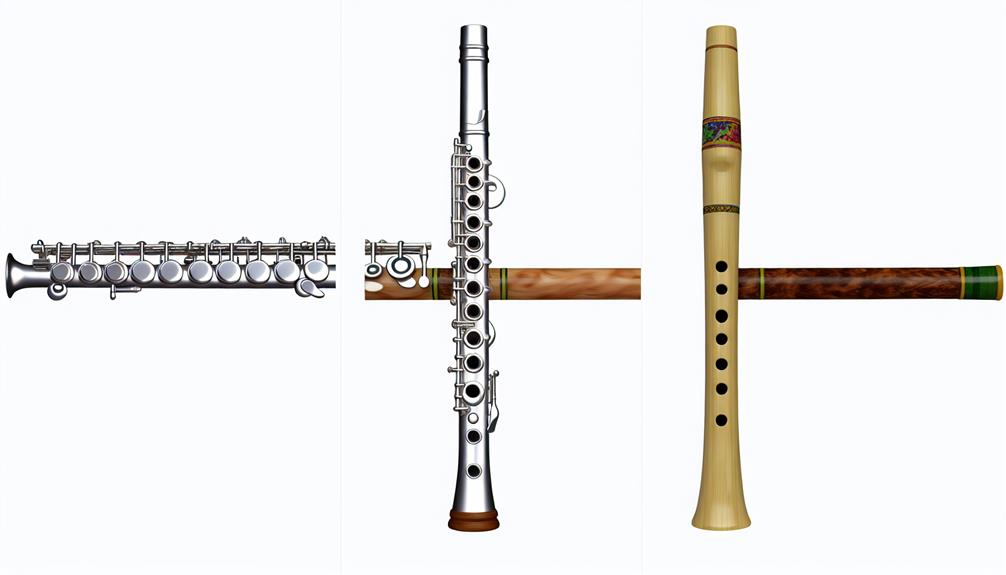The significance of articulation in flute playing cannot be overstated, serving as a cornerstone for achieving precision and musicality in performances. From shaping the character of individual notes to conveying intricate musical phrasing, mastering articulation techniques is essential for flutists aiming to elevate their musical interpretations. By exploring the nuanced relationship between articulation and musical expression, flutists can unlock a world of possibilities to captivate audiences and breathe life into their playing. As we delve further into this topic, we unravel the intricate tapestry that articulation weaves within the realm of flute performance.
Key Takeaways
- Articulation enhances clarity and expression in flute playing.
- Breath control and tongue placement are crucial for articulate performance.
- Nuances in articulation improve emotive quality and musical character.
- Articulation exercises aid in achieving precise control and consistency.
- Developing articulation skills elevates technical proficiency and musical communication.
The Fundamentals of Articulation in Flute Playing
Understanding the fundamental principles of articulation is paramount for achieving clarity and expression in flute playing. Two key components that play a crucial role in articulation are breath control and tongue placement.
Breath control is essential in producing clear and well-defined notes while playing the flute. Proper breath support allows the flutist to maintain a consistent tone quality and control the dynamics of the music. To articulate effectively, one must learn to regulate the airspeed and volume of air passing through the flute. By mastering breath control, flutists can produce articulate and expressive passages that captivate listeners.
Another critical aspect of articulation in flute playing is tongue placement. The position of the tongue affects the attack and release of each note, influencing the clarity and precision of the sound produced. By positioning the tongue correctly, flutists can create crisp articulations and seamless legato passages. Practicing different tongue placements and articulation techniques can help flutists enhance their expressive capabilities and bring out the nuances in their performances.
Techniques for Achieving Articulate Flute Performance
Mastering articulation techniques is essential for achieving a high level of clarity and precision in flute performance. To excel in this area, flutists must focus on developing their embouchure control, finger coordination, breath support, and tongue placement. These fundamental elements play a crucial role in producing articulate and expressive musical phrases. Below is a table outlining key techniques for achieving articulate flute performance:
| Techniques | Description |
|---|---|
| Embouchure Control | Maintain proper lip position and firmness to control airflow and produce clear notes. |
| Finger Coordination | Develop agility and accuracy in finger movements for precise note articulation. |
| Breath Support | Learn to control airflow and maintain consistent breath pressure for sustained phrases. |
| Tongue Placement | Master articulating notes by placing the tongue correctly to initiate clear sound production. |
| Practice Regularly | Dedicate time to daily practice sessions focusing on articulation exercises to improve technique. |
Understanding the Impact of Articulation on Musical Expression
Developing a keen awareness of the nuances of articulation can greatly enhance the depth and emotive quality of musical expression in flute performance. Artistic nuances in articulation refer to the subtle variations in how notes are connected or separated, creating a tapestry of sound that conveys the performer's interpretation of the music. By mastering articulation techniques such as staccato, legato, accents, and more, flutists can imbue their playing with a rich emotional communication that resonates with listeners.
Articulation plays a crucial role in shaping the overall musical expression, allowing the performer to infuse each note with intention and meaning. Through precise control of articulation, flutists can evoke a wide range of emotions, from joy and excitement to sadness and contemplation. By understanding how different articulation styles influence the mood and character of a piece, musicians can craft a more compelling and engaging performance that captivates their audience.
Moreover, mastering the art of articulation empowers flutists to communicate their musical ideas with clarity and poise. It enables them to highlight melodic motifs, create contrast between musical phrases, and convey the dynamic nuances of the composition effectively. By honing their articulation skills, flutists can elevate their musical expression to new heights, captivating listeners with their emotive and nuanced performances.
Common Articulation Challenges Faced by Flutists
One of the common challenges faced by flutists in their playing is achieving consistent and precise articulation control. Articulation precision is crucial for shaping musical phrases and conveying emotions effectively. Flutists often struggle with maintaining clarity and accuracy in their tonguing techniques, which can impact the overall musicality of their performance.
Breath control plays a significant role in articulation, as it directly affects the initiation and release of notes. Inadequate breath support can lead to uneven articulation, resulting in notes that are either too short or too long. Flutists must learn to coordinate their airflow with their tonguing to achieve a seamless and controlled articulation.
Tonguing techniques, such as single tonguing, double tonguing, and triple tonguing, require dedicated practice to master. Each technique offers a unique approach to articulation and can enhance the expressiveness of the music. Flutists may face challenges in developing speed and accuracy in their tonguing, especially when transitioning between different articulation styles within a piece.
Maintaining a balance between articulation precision, breath control, and musicality is essential for flutists to overcome these common challenges. By focusing on these fundamental aspects of playing, flutists can enhance their articulation skills and deliver more engaging and expressive performances.
Articulation Exercises to Improve Flute Playing Skills
To enhance articulation skills in flute playing, incorporating targeted exercises is essential for improving overall performance quality and musical expression. Developing tongue control and achieving articulation clarity are fundamental aspects of mastering the flute. Here are some effective articulation exercises that can help flutists refine their skills:
| Exercise | Description | Benefits |
|---|---|---|
| Single Tonguing | Practice playing a repeated note sequence with a consistent single tongue articulation. | Enhances tongue control and promotes evenness in articulation. |
| Double Tonguing | Alternate between syllables (e.g., ta-ka, tu-ku) to play rapid passages smoothly and evenly. | Improves speed and fluency in articulation for faster passages. |
| Articulation Studies | Focus on specific articulation patterns (e.g., staccato, legato) in scales or etudes to vary articulation styles. | Enhances overall articulation clarity and musical expression. |
Integrating Articulation Into Musical Interpretation
A nuanced integration of articulation techniques into musical interpretation elevates the depth and expressiveness of flute performances. Articulation nuances play a crucial role in shaping the musicality of a piece, allowing the flutist to convey emotions and communicate with the audience effectively. By mastering different articulation styles and understanding how to incorporate them into their interpretation, flutists can breathe life into the music they play.
When exploring articulation nuances, flutists should pay attention to details such as staccato, legato, accents, and dynamics. These elements not only enhance the overall musicality of a performance but also contribute to the authenticity and expressiveness of the interpretation. Experimenting with different articulation styles allows musicians to bring out the subtleties of the music and create a more engaging listening experience for the audience.
In musical interpretation, the integration of articulation goes beyond technical proficiency; it involves infusing personal expression and creativity into the performance. Flutists should strive to develop a deep understanding of the music they are playing, allowing them to make informed decisions about articulation that align with the composer's intentions while also adding their unique touch to the interpretation.
Frequently Asked Questions
How Does Articulation Affect Tone Production on the Flute?
Articulation techniques play a crucial role in shaping tone quality on the flute. By varying articulation, such as tonguing or legato playing, flutists can control the attack, sustain, and release of each note, ultimately influencing the overall sound produced.
Consistent and precise articulation enhances clarity, expressiveness, and musicality in performances. Practicing different articulation techniques diligently can help flutists achieve a wide range of dynamics and colors in their playing.
Can Articulation Be Improved Through Breathing Exercises?
Just as a skilled gardener nurtures a delicate flower, breath control is the foundation for improving articulation in flute playing.
By engaging in specific articulation exercises that focus on breath control, flutists can develop precision and clarity in their playing.
Consistent practice and attention to the nuances of airflow and tongue placement can lead to significant improvements in articulation, creating a more polished and expressive performance.
Are There Specific Articulation Techniques for Fast Passages?
When addressing articulation dynamics in fast passages on the flute, it is essential to focus on precision and control. Utilizing techniques such as double tonguing, flutter tonguing, and finger coordination can help achieve clarity and speed in articulation.
Practicing with a metronome at varying tempos and gradually increasing speed can also aid in developing agility and fluency in fast passages. Consistent practice and attention to detail are key in mastering articulation in rapid musical segments.
What Role Does Articulation Play in Conveying Emotions in Music?
Articulation techniques are fundamental in shaping the emotional expression of music.
The way a musician articulates notes through techniques like staccato, legato, or accents can significantly impact the overall mood and convey a range of emotions to the listener.
How Can Articulation Help With Phrasing and Musical Storytelling?
Articulation serves as the brushstrokes of a painting, allowing a musician to shape phrases and convey a narrative through dynamic variations and precise technique.
In the realm of musical expression, articulation plays a crucial role in capturing the nuances of a piece, guiding the listener through a journey of musical storytelling.
Conclusion
In conclusion, the mastery of articulation in flute playing is essential for achieving clarity, expressiveness, and musicality in performances. By honing techniques such as breath control, tongue placement, and finger coordination, flutists can navigate through challenges and enhance their musical interpretation.
Engaging in articulation exercises and integrating these skills into practice will lead to more captivating and expressive musical performances, enriching the overall musical experience for both the performer and the audience.





